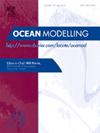Quantification of multi-source contributions to volume transport in the Tsushima Strait
IF 2.9
3区 地球科学
Q2 METEOROLOGY & ATMOSPHERIC SCIENCES
引用次数: 0
Abstract
As the sole channel connecting both the East China Sea and the Yellow Sea to the Sea of Japan, the contribution of specific sources of volume transport in the Tsushima Strait remains unknown. Using the Lagrangian trajectory model TRACMASS, this study identifies the sources of volume transport through the Tsushima Strait and quantifies the contributions from three major pathways: the East Taiwan Channel, the Taiwan Strait, and the Northern Yellow Sea. The model accurately reproduces the persistent quasi-unidirectional current that transports water through the Tsushima Strait into the Sea of Japan throughout the year. The East Taiwan Channel and Taiwan Strait serve as the principal contributors to the Tsushima Strait’s volume transport, accounting for 1.58 Sv (51.8 %) and 1.04 Sv (34.1 %), respectively. However, the Northern Yellow Sea makes a relatively minor contribution of 0.17 Sv (5.7 %). Volume transport through the Tsushima Strait is primarily sourced from the East Taiwan Channel for most of the year, exhibiting bimodal seasonal peaks in April and November driven by intensified Kuroshio shelf intrusion. In contrast, the Taiwan Strait becomes the dominant contributor during August and September, when strengthened transport occurs under the combined influence of the Taiwan Warm Current and monsoon transition. Volume transport from the Northern Yellow Sea to the Tsushima Strait is primarily driven by the Korean Coastal Current. In addition, the runoff and long-resident water masses retained within the East China Sea and the Yellow Sea also serve as supplementary contributors to the transport of Tsushima Strait.
对马海峡体积运输多源贡献的量化
作为连接东海和黄海与日本海的唯一通道,对马海峡的具体运输量来源的贡献尚不清楚。利用拉格朗日轨迹模式TRACMASS,本文确定了对马海峡的体积输送来源,并量化了三个主要途径:台湾海峡东部、台湾海峡和黄海北部。该模型准确地再现了全年将水通过对马海峡输送到日本海的持续准单向洋流。东台湾海峡和台湾海峡是对马海峡运量的主要来源,分别占1.58 Sv(51.8%)和1.04 Sv(34.1%)。然而,北黄海的贡献相对较小,为0.17 Sv(5.7%)。在一年中的大部分时间里,通过对马海峡的运输量主要来自东台湾海峡,在黑潮陆架入侵加剧的驱动下,在4月和11月出现双峰季节性高峰。8月和9月,台湾暖流和季风转变共同影响下,台湾海峡成为主要的输送源。从黄海北部到对马海峡的运输主要是由朝鲜海岸流驱动的。此外,东海和黄海内滞留的径流和长期驻留的水团也对对马海峡的输送起到补充作用。
本文章由计算机程序翻译,如有差异,请以英文原文为准。
求助全文
约1分钟内获得全文
求助全文
来源期刊

Ocean Modelling
地学-海洋学
CiteScore
5.50
自引率
9.40%
发文量
86
审稿时长
19.6 weeks
期刊介绍:
The main objective of Ocean Modelling is to provide rapid communication between those interested in ocean modelling, whether through direct observation, or through analytical, numerical or laboratory models, and including interactions between physical and biogeochemical or biological phenomena. Because of the intimate links between ocean and atmosphere, involvement of scientists interested in influences of either medium on the other is welcome. The journal has a wide scope and includes ocean-atmosphere interaction in various forms as well as pure ocean results. In addition to primary peer-reviewed papers, the journal provides review papers, preliminary communications, and discussions.
 求助内容:
求助内容: 应助结果提醒方式:
应助结果提醒方式:


